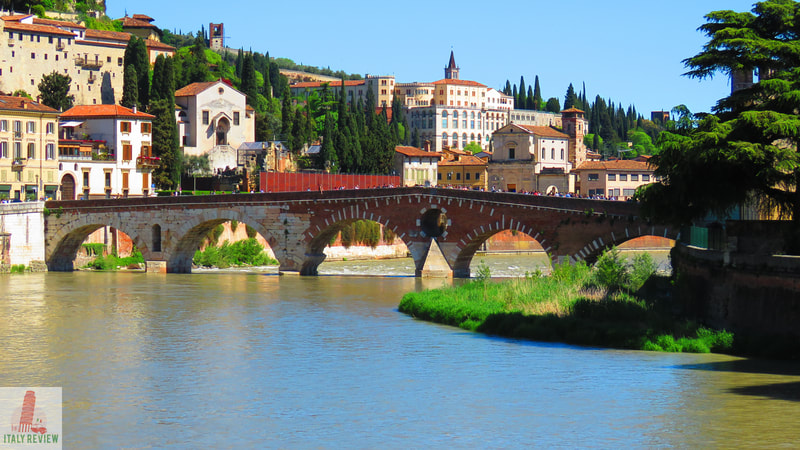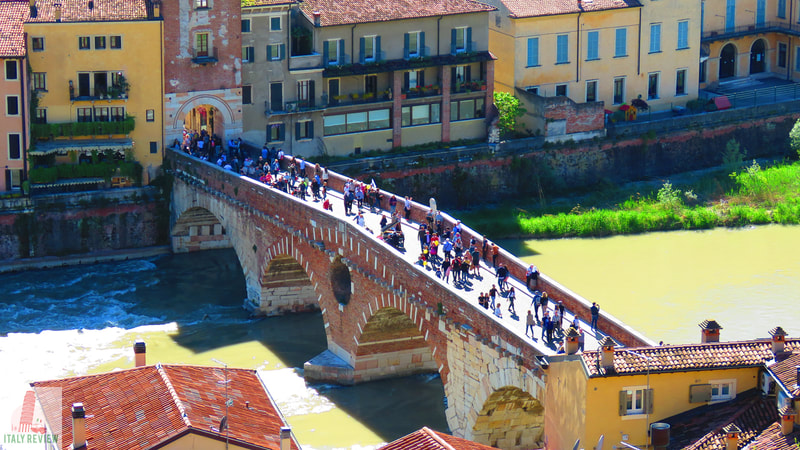Ponte Pietra
|
By Dion Protani
|
Latest update: 21 January 2024
|
|
The Ponte Pietra is a landmark bridge that spans the River Adige in the city of Verona in the Veneto region. Originally built in 100 BC, four of its arches were blown up by German soldiers in World War Two but rebuilt in 1957 using the original materials.
Translating literally as "Stone Bridge", it measures 120 metres in length it connects Verona's Città Antica and Veronetta areas. |
Related links
Profile
Ponte Pietra, also known as Stone Bridge, is an ancient Roman bridge located in Verona, Italy. It is one of the most iconic and historically significant landmarks in the city. The bridge spans the Adige River and has a long and eventful history, making it a popular attraction for tourists visiting Verona.
It's a stone bridge with three arches, characterized by its elegant and sturdy Roman architecture. The bridge is approximately 120 meters long and about 9 meters wide. It is made of white limestone, which gives it a distinctive appearance against the backdrop of the river and the surrounding cityscape.
The central arch is the largest and spans the widest part of the river, while the two smaller arches on either side provide additional support. From the bridge, visitors can enjoy picturesque views of the Adige River and the historic buildings along its banks.
It's a stone bridge with three arches, characterized by its elegant and sturdy Roman architecture. The bridge is approximately 120 meters long and about 9 meters wide. It is made of white limestone, which gives it a distinctive appearance against the backdrop of the river and the surrounding cityscape.
The central arch is the largest and spans the widest part of the river, while the two smaller arches on either side provide additional support. From the bridge, visitors can enjoy picturesque views of the Adige River and the historic buildings along its banks.
History
The construction of Ponte Pietra dates back to ancient Roman times, as early as the 1st century BC. The original bridge was likely a wooden structure, but it was later rebuilt in stone by the Romans during the reign of Emperor Augustus. Over the centuries, the bridge underwent several restorations and repairs due to natural disasters, including floods and the destructive forces of war.
During World War II, the retreating German troops destroyed all the bridges in Verona, including Ponte Pietra, in an attempt to hinder the advance of the Allied forces. After the war, the bridge was meticulously reconstructed, and the original stones were carefully reassembled to preserve its historical integrity.
During World War II, the retreating German troops destroyed all the bridges in Verona, including Ponte Pietra, in an attempt to hinder the advance of the Allied forces. After the war, the bridge was meticulously reconstructed, and the original stones were carefully reassembled to preserve its historical integrity.
Key features and nearby attractions
- Location: Ponte Pietra is situated in the historic center of Verona, just a short walk from the famous Verona Arena and other notable attractions.
- Access: The bridge is open to both pedestrians and vehicles, allowing visitors to cross the Adige River and explore the city on foot.
- Sunset Views: Ponte Pietra is a particularly popular spot to enjoy a sunset over the Adige River, creating a romantic and picturesque setting for visitors.
- Nearby Attractions: While visiting the bridge, tourists can also explore nearby attractions, including the Roman Theater, the Scaliger Tombs, and the Piazza delle Erbe.
- Guided Tours: Consider joining a guided tour of Verona to gain a deeper understanding of the historical significance of Ponte Pietra and other landmarks in the city.
- Photography: The bridge provides excellent photo opportunities, especially during sunrise and sunset, when the soft light illuminates the stone structure.
Ponte Pietra
|
City: Verona
Province: Verona Region: Veneto Completed: 100 BC Architectural style: Ancient Roman Length: 120 metres Crosses: River Adige Close by: Roman Theatre of Verona, Piazza Bra, Verona Arena Recommended accommodation: Hotel Accademia |























